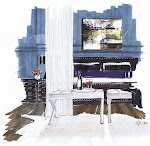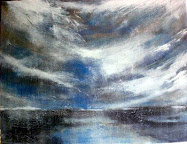 *Due to the horrendous formatting issues with blogger, and my long list of books, I will be doing two more entries :)
*Due to the horrendous formatting issues with blogger, and my long list of books, I will be doing two more entries :) Shaping Interior Space- Roberto J Rengel
Shaping Interior Space- Roberto J RengelIf you only read the first chapter of this book, you would get allot out of it. The reviews at the end of every chapter bring all the information together well, and if I had an hour or so, I would read just those.
A quote from LeCorbusier's "Towards a New Architecture" (Dover Publications: New York, 1968) from that first chapter reads:
This is what has always intrigued me about interior design...that you are capable of creating and manipulating feelings with interior space. I am an advocate of nature inspired interiors, and our relationship to the outdoors; that's no secret, and often look to the feeling of walking through the rainforest, the scale of the bog trees or the colour of bark to bring inside.
The power of design comes in creating spaces that are nurturing, in the case of court houses, or hospitals, where you feel safe and secure. In creating a space of gradure and worship that stretches to the sky, and includes an element of natural light that casts the perfect shadow; one that makes you raise your hands up. To create a getaway space that cocoons you in such a way, you can't explain it, but you need to return every year. This is the power of design.
 This page on free standing, and attached masses is definitely interesting!
This page on free standing, and attached masses is definitely interesting!
 The Interior Design Business Handbook - Mary V. Knackstedt
The Interior Design Business Handbook - Mary V. Knackstedt I have used it many times, and my first contract was moulded from the one in the middle of the book. I saw Mary last week at the Seattle Design Center; you can read about it here.

This page of the book talks about fee structure; cost plus, percentage, hourly fees, and hybrids.

Home- Witold Rybezynski
The sub-title of this book pretty much says it all..."A Short History of an Idea". Ralph Lauren and his marketing genius is examined, as is what we think comfort is...not just physical comfort, but safety as comfort. He looks over the centuries to what has made us react in the way that we have to furniture, and interior spaces.
A great little book, and an perfect size read for a trip.

Designing Interiors- Rosemary Kilmer W. Otie Kilmer
Concept, FF & E, adjacency matrix, programming, bubbling, lighting, materials, history of design or technical drawing...this is the source! I have more post-its in this book than any other. This book takes you through the design process (or the domains) from programming through ideation and occupancy.

Page 164-165 features bubble and conceptual diagrams, ideation and schematics (my favorite part of design).
 Colour Drawing- Micheal E. Doyle
Colour Drawing- Micheal E. Doyle
Like I have said before, drawing and rendering can be learned! There are artists, and then there are those who read books like this, practice the techniques, no matter how much they suck, and learn to do it better next time.
Information and diagrams on shadows, blending, night scenes, materials, mediums, and indispensable techniques make this book one of my favorites. I learned later in school to use Sketch-up for perspectives, but typically use hand rendering on top of those dwgs for character.
Don't say you can't draw, until you read this book!

Notice the background of the shelves is shaded first, colour is added, details are brushed in, leaving white space around the rendering, and adding "glints and gleams" for lighting.
Part 2 of ID texts is coming soon!




6 comments:
So Funny - I have all of those books!
Great Source - Thanks for sharing :)
I recommend any book by Witold Rybezynski -he's my favorite author!
I couldn't agree more with your selections - Designing Interiors is my most used book as well as Color Drawing (my rendering Bible). Another one of my personal favorites is The Abrams Guide to Period Styles for Interiors by Judith Gura (had her for a professor).
Absolutely LOVE your blog, btw!
Nice of you to stop by Stamford! Welcome! I hope you come back to visit!
AD- me to Stefan! I like his casual research style...effortless and understandable! Novelesce.
I enjoy your blog. I'm going to order the drawing book and start practicing.
Post a Comment